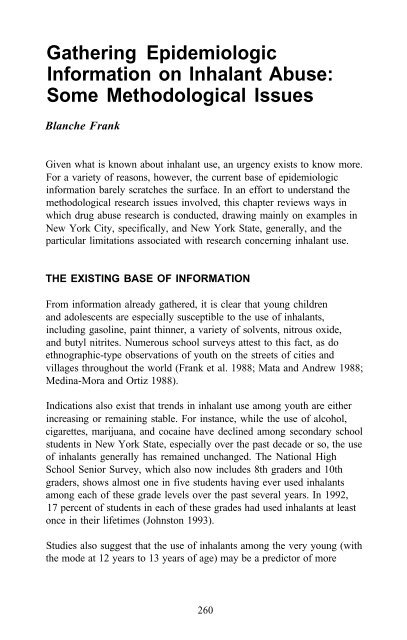Epidemiology of Inhalant Abuse - Archives - National Institute on ...
Epidemiology of Inhalant Abuse - Archives - National Institute on ...
Epidemiology of Inhalant Abuse - Archives - National Institute on ...
Create successful ePaper yourself
Turn your PDF publications into a flip-book with our unique Google optimized e-Paper software.
Gathering Epidemiologic<br />
Informati<strong>on</strong> <strong>on</strong> <str<strong>on</strong>g>Inhalant</str<strong>on</strong>g> <str<strong>on</strong>g>Abuse</str<strong>on</strong>g>:<br />
Some Methodological Issues<br />
Blanche Frank<br />
Given what is known about inhalant use, an urgency exists to know more.<br />
For a variety <str<strong>on</strong>g>of</str<strong>on</strong>g> reas<strong>on</strong>s, however, the current base <str<strong>on</strong>g>of</str<strong>on</strong>g> epidemiologic<br />
informati<strong>on</strong> barely scratches the surface. In an effort to understand the<br />
methodological research issues involved, this chapter reviews ways in<br />
which drug abuse research is c<strong>on</strong>ducted, drawing mainly <strong>on</strong> examples in<br />
New York City, specifically, and New York State, generally, and the<br />
particular limitati<strong>on</strong>s associated with research c<strong>on</strong>cerning inhalant use.<br />
THE EXISTING BASE OF INFORMATION<br />
From informati<strong>on</strong> already gathered, it is clear that young children<br />
and adolescents are especially susceptible to the use <str<strong>on</strong>g>of</str<strong>on</strong>g> inhalants,<br />
including gasoline, paint thinner, a variety <str<strong>on</strong>g>of</str<strong>on</strong>g> solvents, nitrous oxide,<br />
and butyl nitrites. Numerous school surveys attest to this fact, as do<br />
ethnographic-type observati<strong>on</strong>s <str<strong>on</strong>g>of</str<strong>on</strong>g> youth <strong>on</strong> the streets <str<strong>on</strong>g>of</str<strong>on</strong>g> cities and<br />
villages throughout the world (Frank et al. 1988; Mata and Andrew 1988;<br />
Medina-Mora and Ortiz 1988).<br />
Indicati<strong>on</strong>s also exist that trends in inhalant use am<strong>on</strong>g youth are either<br />
increasing or remaining stable. For instance, while the use <str<strong>on</strong>g>of</str<strong>on</strong>g> alcohol,<br />
cigarettes, marijuana, and cocaine have declined am<strong>on</strong>g sec<strong>on</strong>dary school<br />
students in New York State, especially over the past decade or so, the use<br />
<str<strong>on</strong>g>of</str<strong>on</strong>g> inhalants generally has remained unchanged. The <str<strong>on</strong>g>Nati<strong>on</strong>al</str<strong>on</strong>g> High<br />
School Senior Survey, which also now includes 8th graders and 10th<br />
graders, shows almost <strong>on</strong>e in five students having ever used inhalants<br />
am<strong>on</strong>g each <str<strong>on</strong>g>of</str<strong>on</strong>g> these grade levels over the past several years. In 1992,<br />
17 percent <str<strong>on</strong>g>of</str<strong>on</strong>g> students in each <str<strong>on</strong>g>of</str<strong>on</strong>g> these grades had used inhalants at least<br />
<strong>on</strong>ce in their lifetimes (Johnst<strong>on</strong> 1993).<br />
Studies also suggest that the use <str<strong>on</strong>g>of</str<strong>on</strong>g> inhalants am<strong>on</strong>g the very young (with<br />
the mode at 12 years to 13 years <str<strong>on</strong>g>of</str<strong>on</strong>g> age) may be a predictor <str<strong>on</strong>g>of</str<strong>on</strong>g> more<br />
260
















